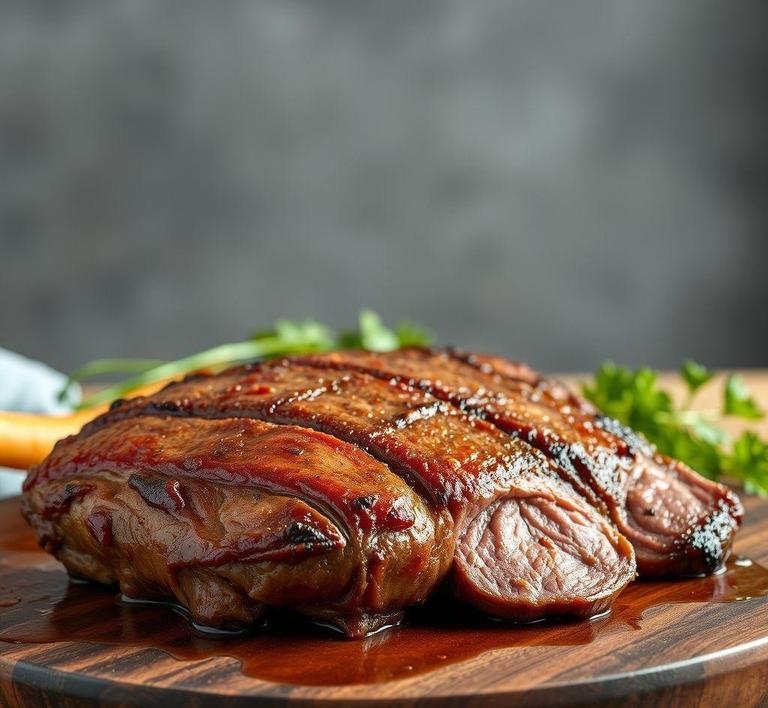If you’ve found yourself with leftover roast beef and are wondering whether you can safely refreeze it, you’re not alone. The question of refreezing cooked meat can be a bit tricky, but don’t worry – with the right steps, you can keep that delicious roast beef safe for later use! In this guide, we’ll walk you through the best practices for refreezing cooked roast beef so you can enjoy it another day without compromising flavor or safety. Whether you’re trying to stretch out your meal prep or just love a good roast beef sandwich, we’ve got you covered.
Can You Refreeze Cooked Roast Beef?

Yes, you can refreeze cooked roast beef-but with important caveats.
The key consideration is whether the meat has been previously thawed properly and kept at a safe temperature. If your roast beef was originally frozen, then thawed in the refrigerator (not on the counter or in warm water), and has not been sitting at room temperature for more than two hours (or one hour in hotter climates), then it is safe to refreeze.
The USDA confirms that it is safe to refreeze previously frozen food that has been cooked-as long as it was thawed safely and hasn’t reached the temperature ‘danger zone’ (between 40°F and 140°F), where bacteria multiply rapidly.
However, each freeze-thaw cycle affects the meat’s texture and moisture content. Therefore, while it’s safe, there’s a trade-off with quality-more on that in a moment.
How To Refreeze Cooked Roast Beef?
If you’ve determined your cooked roast beef is still within safe handling guidelines, here’s a step-by-step guide to refreezing it properly:
-
Let It Cool (Safely):
Before freezing, allow the cooked roast beef to cool to room temperature, but don’t leave it out for more than 2 hours (1 hour if it’s above 90°F/32°C). To expedite cooling, slice the beef or spread it out in a shallow dish.
-
Divide into Portions:
For easier future use, divide the beef into meal-sized portions. This also helps prevent unnecessary repeated thawing and refreezing, which can further compromise quality and safety.
-
Wrap It Right:
Use moisture- and air-proof packaging. Wrap portions tightly in plastic wrap or aluminum foil, and then place them in heavy-duty freezer bags or airtight containers. Remove as much air as possible to prevent freezer burn.
-
Label Clearly:
Write the date of freezing on each package. Cooked beef is best consumed within 2-3 months after refreezing for optimal flavor and texture.
-
Freeze Promptly:
Place the packaged roast beef in the coldest part of your freezer. Avoid putting hot or warm meat directly into the freezer as it can raise the internal temperature and risk other items’ safety.
Quality Impact
This is where things get a bit more nuanced. While refreezing cooked roast beef is technically safe under the right conditions, the process can have a noticeable impact on quality.
Here’s what happens:
-
Texture Degradation:
Freezing forms ice crystals inside the meat. Upon thawing, these crystals break down the muscle fibers, making the meat mushier or more crumbly. This effect is exacerbated with each additional freeze-thaw cycle. A beautifully cooked medium-rare roast can become dry or stringy after its second time in the freezer.
-
Moisture Loss:
Cooked beef already contains less moisture than raw meat, and freezing causes further moisture loss. When thawed and reheated, the meat may seem drier than it originally was.
-
Flavor Dulling:
While roast beef won’t necessarily develop off-flavors if frozen and thawed correctly, the robust savory notes that make it so enjoyable fresh might become more muted over time. Spices and seasoning can also fade or become uneven after freezing.
Tips to Mitigate Quality Loss:
- Reheat gently: Use low, slow heat or sous-vide methods to retain moisture and texture.
- Use in different dishes: If the roast beef isn’t quite as juicy as it once was, consider incorporating it into stews, soups, hash, quesadillas, or sandwiches, where the texture change is less noticeable.
Yes-you can refreeze cooked roast beef, as long as it was thawed and handled properly. The practice is safe, but it does come with a compromise in quality, particularly in texture and moisture content. By portioning wisely, wrapping well, and using the meat creatively in future meals, you can still make the most out of your roast without letting any of it go to waste.
In the end, proper storage practices and an awareness of safe food handling will always be your best allies in the kitchen. Whether you’re a thrifty home cook or a busy parent looking to prep meals ahead, refreezing roast beef-when done thoughtfully-can be a valuable part of your culinary toolkit.
Is It Safe To Refreeze Cooked Roast Beef?
Yes, it is generally safe to refreeze cooked roast beef-but only under specific conditions that prioritize food safety. The most crucial factor in determining whether refreezing is safe is how the beef was handled after it was initially cooked and thawed.
If the roast beef was thawed in the refrigerator and has been kept below 40°F (4°C) the entire time, it is safe to refreeze. Refrigeration slows down bacterial growth, ensuring that the meat remains safe to eat even after another freeze-thaw cycle. However, every time food is thawed and refrozen, its texture and flavor can degrade slightly. While the nutritional value remains mostly intact, moisture loss during each cycle may make the beef a bit drier or tougher upon reheating.
On the other hand, if the cooked roast beef was thawed using quicker methods-such as in the microwave or by leaving it out at room temperature-it should not be refrozen. These methods bring the meat into the temperature "danger zone" (40°F-140°F), where bacteria multiply rapidly. Even if the meat appears fine, harmful pathogens may have begun to develop, making refreezing unsafe.
Signs That Cooked Roast Beef Should Not Be Refrozen
Refreezing roast beef that’s past its prime can lead to foodborne illness. Here are clear indicators that the beef is no longer safe to freeze-or eat:
- Off Odor: A strong, sour, or rancid smell is a red flag. Spoiled beef often emits a pungent, unpleasant aroma that intensifies upon exposure to air.
- Slimy or Sticky Texture: If the meat feels tacky, sticky, or slimy to the touch, it has likely developed bacterial or mold growth.
- Discoloration: A gray or greenish tint on cooked beef may indicate spoilage. While some oxidation is natural, an unusual hue suggests it’s not safe to refreeze or consume.
- Presence of Mold: Any visible mold growth-no matter how small-means the entire piece should be discarded. Mold spreads beneath the surface and is not always visible.
- Unrefrigerated Exposure: If the beef sat out for more than two hours (or more than one hour in temperatures above 90°F/32°C), it has entered the danger zone and is no longer safe to refreeze.
Common Refreezing Mistakes
Even well-intentioned cooks can make errors when handling leftovers. These are the most frequent mistakes that should be avoided:
- Refreezing After Room Temperature Thawing: As noted earlier, thawing cooked roast beef on the counter is unsafe. Refreezing it afterward can trap harmful bacteria.
- Repeated Freeze-Thaw Cycles: Constantly thawing and refreezing meat accelerates quality loss and increases the risk of contamination.
- Freezing in Large Portions: Big chunks take longer to freeze and thaw, increasing the risk of uneven temperatures. This can create breeding grounds for bacteria in the center of the portion.
- Using Improper Storage Containers: Not sealing the meat properly allows for freezer burn, which dehydrates the beef and affects flavor and texture. Always use airtight, freezer-safe containers or vacuum-sealed bags.
- Forgetting to Label and Date: Without knowing when the beef was first cooked or refrozen, you risk keeping it too long. Even frozen foods have limits-cooked beef is best used within 2-3 months for optimal quality.
✨ Tips And Tricks For Safely Refreezing Cooked Roast Beef
Here’s how to maximize both safety and quality when refreezing your roast beef:
- Cool Before Freezing: Allow cooked roast beef to cool fully (within 1-2 hours) before placing it in the freezer. Freezing warm food raises the temperature of your freezer and compromises other items.
- Portion Strategically: Divide leftovers into single-serving or meal-sized portions. This way, you only thaw what you need, minimizing waste and limiting how often food is handled.
- Use Vacuum Sealers or Freezer-Safe Bags: Reducing exposure to air keeps the beef fresher and prevents freezer burn. Squeeze out excess air or use a vacuum sealer for the best results.
- Label Clearly: Always write the date, contents, and any notes (e.g., ‘Refrozen on May 10th’) to track how long it’s been stored.
- Reheat Thoroughly: When it’s time to enjoy your roast beef again, make sure to heat it to an internal temperature of 165°F (74°C) to kill any lingering bacteria.
Conclusion
Refreezing cooked roast beef can be safe and effective, provided you follow the proper steps and remain vigilant for signs of spoilage. By understanding how temperature, timing, and storage methods interact, you can avoid health risks and preserve both the flavor and integrity of your meals.
Think of it like this: Your freezer is not just a storage space-it’s a tool for extending the life of food without sacrificing safety. Treat your roast beef with care and attention, and it’ll reward you with delicious leftovers that taste nearly as good as the original roast.
If you’re unsure whether to refreeze something, remember the golden rule: ‘When in doubt, throw it out.’ A cautious approach ensures that your kitchen remains both satisfying and safe.


